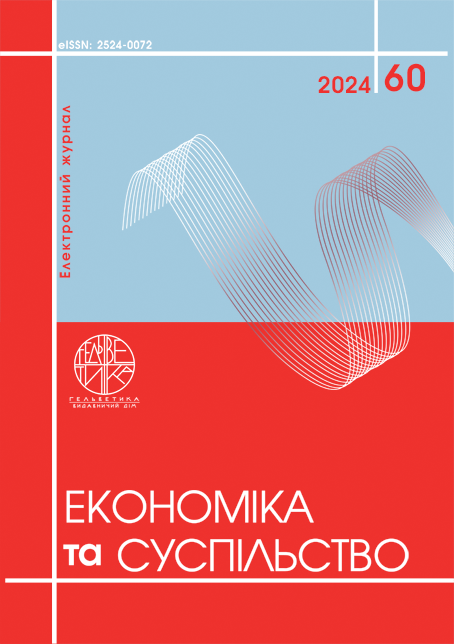БІЗНЕС-СТРАТЕГІЇ ПІДПРИЄМСТВ В УМОВАХ ВОЄННОЇ ЕКОНОМІКИ
Анотація
Встановлено, що довгострокове стратегічне планування втратило сенс, необхідно впроваджувати нові стратегії зорієнтовані на пошук ринкових можливостей, експериментування та розвиток конкурентної переваги. Таке управління підприємством також базується на аналізі ресурсів і зовнішнього середовища, але візія, місія та цілі підприємства не визначені остаточно. Доведено, що у турбулентному бізнес-середовищі найціннішими для компанії є динамічні здатності. Вони є видом абстрактних здатностей, які дозволяють відчувати та використовувати можливості та передбачати загрози. Обґрунтовано, що для вибору стратегії в умовах воєнної економіки необхідно враховувати три аспекти: стратегічний контекст, процес створення стратегії та зміст стратегії. Це виміри, які взаємодіють один з одним Незалежно від того, яку з цих форм стратегії вибере підприємство, вона повинна ґрунтуватися на припущеннях, які менеджери мають розглядати як керівні принципи: відкритість, гнучкість, навчання, підприємливість і підтримка змін.
Посилання
Czapla A. Strategie biznesowe w warunkach niepewności - działania przedsiębiorstw w czasie pandemii COVID-19. ZN WSH. Zarządzanie. 2022 (4). S. 2022. 107–120. DOI: 10.5604/01.3001.0016.2181.
Hoffman F.O., Hammonds J.S. Propagation of uncertainty in risk assessments: The need to distinguish between uncertainty due to lack of knowledge and uncertainty due to variability. «Risk Analysis» 1994. T. 14. Nr. 5.
Moore A. Measuring economic uncertainty and its effects. «Economic Record». 2017. T. 93. Nr. 303.
Семенча І. Є., Гордієнко С. О. Формування стратегії розвитку бізнесу з урахуванням умов воєнної економіки України. Економічний простір. 2022. № 181. С. 143–150. DOI: https://doi.org/10.32782/2224-6282/181-25. URI: http://srd.pgasa.dp.ua:8080/xmlui/handle/123456789/9812. (Дата звернення: 29.02.2024)
Втрати від війни.URL: https://www.ukrinform.ua/rubric-economy/3827 525. (Дата звернення: 29.02.2024)
Mintzberg H., Lampel J., Quinn J.B., Ghoshal S. The strategy process: Concepts, contexts, cases. Pearson Education. Edinburgh. Harlow. Essex. 2002.
The art of the long view. New York. Doubleday. 2001. 450 р.
Strategic Management: Consept and Cases. University of Alabama. Business Publication Inc. 4-th ed. Plano. Texas. 1987. 345 p.
Chandler A.D. Strategy and structure: Chapters in the history of the industrial enterprise. Boston. MA: MIT. Press.1962.
Corporate Strategy: Resources and the Scope of the Firm. Irwin. Chicago. 2007. 570 p.
Mintzberg H., Ahlstrand B., Lampel J. Strategy Safari: A Guided Tour through the Wilds of Strategic Management, Free Press. New York. 1998.
Quinn J.B., Strategies for change: Logical incrementalism, Irwin, Homewood 1980.
Lynch R. Strategic management. Pearson. Harlow. 2015.
Eisenhardt K.M., Martin J.A. Dynamic capabilities: what are they? Strategic Management Journal. 2000. T. 21. Nr. 10/11. S. 1105–112.
Teece D.J., Pisano G., Shuen A. Dynamic capabilities and strategic management. Strategic Management Journal. 1997. T. 18. Nr 7. S. 509–533.
Mitręga M. Dynamic marketing capability – refining the concept and applying it to company innovations. Journal of Business & Industrial Marketing. 2019. T. 35. Nr 2. S. 193–203.
Teece D.J. Explicating dynamic capabilities: The nature and microfoundations of (sustainable) enterprise performance. Strategic Management Journal. 2007. Nr 28. S. 1319-13.
Verreynne M.L., Hine D., Coote L., Parker R. Building a scale for dynamic learning capabilities: The role of resources, learning, competitive intent and routine patterning. Journal of Business Research. 2016. T. 69. Nr 10.S. 4287-430.
Генрі Міцберґ Анатомія менеджменту. Ефективний спосіб керувати компанією. Наш формат. Київ. 2018.408 с.
Hine D., Parker R., Pregelj L., Verreynne M. Deconstructing and reconstructing the capability hierarchy.Industrial and Corporate Change. 2014. T. 23. Nr. 5. S. 1299-1325.
Czapla A. (2022).Strategie biznesowe w warunkach niepewności – działania przedsiębiorstw w czasie pandemii COVID-19. ZN WSH. Zarządzanie. (4). S. 107-120. DOI: 10.5604/01.3001.0016.2181.
Hoffman F.O., Hammonds J.S. (1994). Propagation of uncertainty in risk assessments: The need to distinguish between uncertainty due to lack of knowledge and uncertainty due to variability. «Risk Analysis». T. 14. Nr. 5.
Moore A.(2017). Measuring economic uncertainty and its effects. «Economic Record». T. 93. Nr. 303.
Semencha I. Ye., Hordiienko S. O.(2022). Formuvannia stratehii rozvytku biznesu z urakhuvanniam umov voiennoi ekonomiky Ukrainy.[ Formation of a business development strategy taking into account the conditions of the military economy of Ukraine]. Ekonomichnyi prostir. 2022. № 181. pp.143–150. DOI: https://doi.org/10.32782/2224-6282/181-25. URI: http://srd.pgasa.dp.ua:8080/ xmlui/handle/123456789/9812. (Аccessed February 29, 2024).
Vtraty vid viiny. [Losses from the war] .URL: https://www.ukrinform.ua/ rubric-economy/3827525. (Аccessed February 29, 2024).
Mintzberg H., Lampel J., Quinn J.B., Ghoshal S. (2002). The strategy process: Concepts, contexts, cases. Pearson Education. Edinburgh. Harlow. Essex.
The art of the long view. New York. Doubleday. 2001. 450 р.
Strategic Management: Consept and Cases. University of Alabama. Business Publication Inc. 4-th ed. Plano. Texas. 1987. 345 p.
Chandler A.D. (1962) Strategy and structure: Chapters in the history of the industrial enterprise. Boston. MA: MIT. Press.
Corporate Strategy: Resources and the Scope of the Firm. Irwin. Chicago. 2007. 570 p.
Mintzberg H., Ahlstrand B., Lampel J.(1998). Strategy Safari: A Guided Tour through the Wilds of Strategic Management, Free Press. New York.
Quinn J.B. (1980). Strategies for change: Logical incrementalism, Irwin, Homewood
Lynch R.(2015). Strategic management. Pearson. Harlow.
Eisenhardt K.M., Martin J.A. (2 000). Dynamic capabilities: what are they? Strategic Management Journal. T. 21. Nr 10/11. S. 1105–112.
Teece D.J., Pisano G., Shuen A. (1997). Dynamic capabilities and strategic management. Strategic Management Journal. T. 18. Nr 7. S. 509–533.
Mitręga M.(2019). Dynamic marketing capability – refining the concept and applying it to company innovations. Journal of Business & Industrial Marketing. T. 35. Nr 2. S. 193–203.
Teece D.J.(2007). Explicating dynamic capabilities: The nature and microfoundations of (sustainable) enterprise performance. Strategic Management Journal. Nr 28. S. 1319–13.
Verreynne M.L., Hine D., Coote L., Parker R. (2016). Building a scale for dynamic learning capabilities: The role of resources, learning, competitive intent and routine patterning. Journal of Business Research.T. 69. Nr 10.S. 4287–430.
Mintsberh, H. (2018). Anatomiia menedzhmentu. Efektyvnyj sposib keruvaty kompaniieiu.[Anatomy of management. An effective way to manage a company]. Kyiv: Nash format [in Ukrainian]
Hine D., Parker R., Pregelj L., Verreynne M. (2014). Deconstructing and reconstructing the capability hierarchy.Industrial and Corporate Change. T. 23. Nr. 5. S. 1299–1325.

Ця робота ліцензується відповідно до Creative Commons Attribution 4.0 International License.


